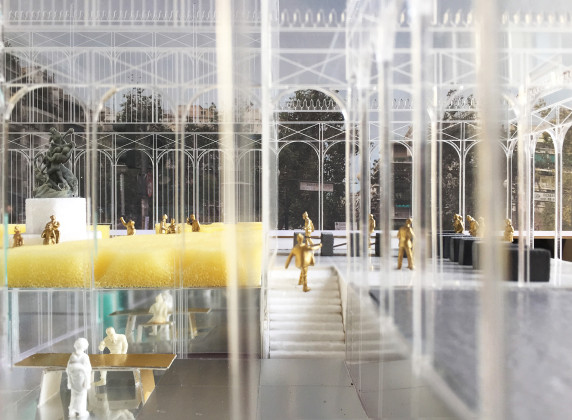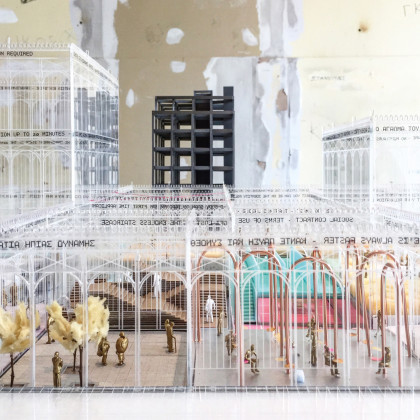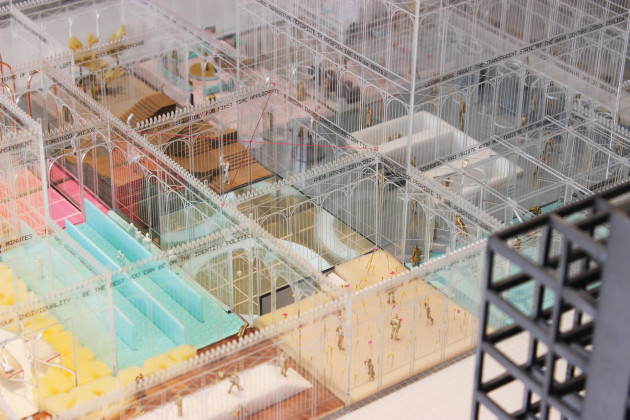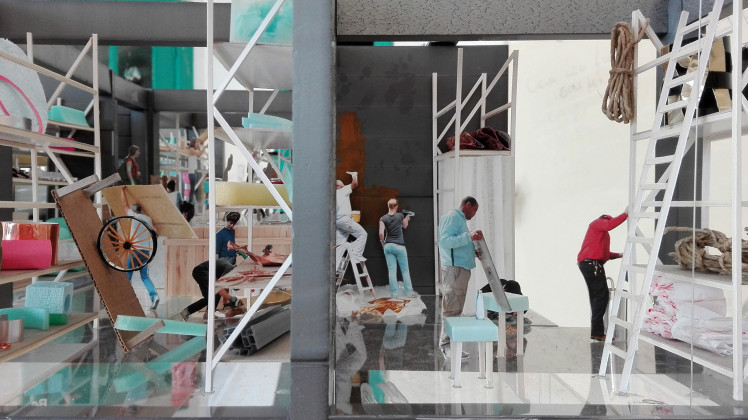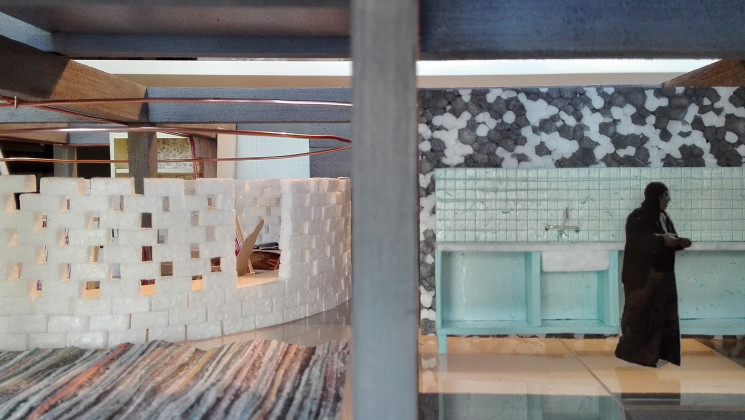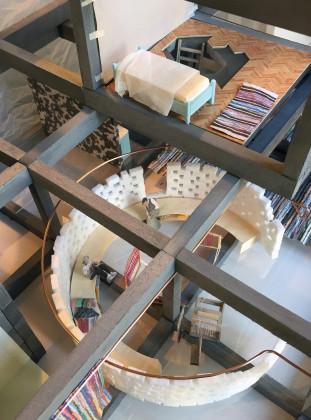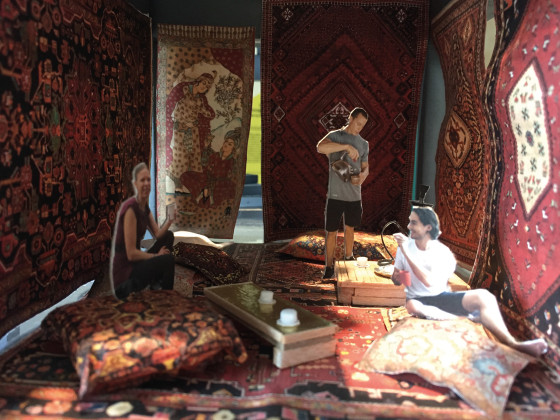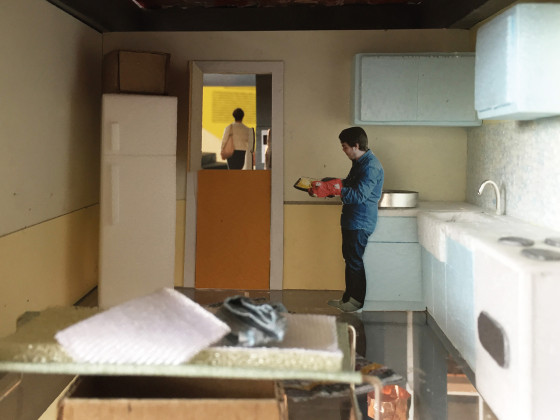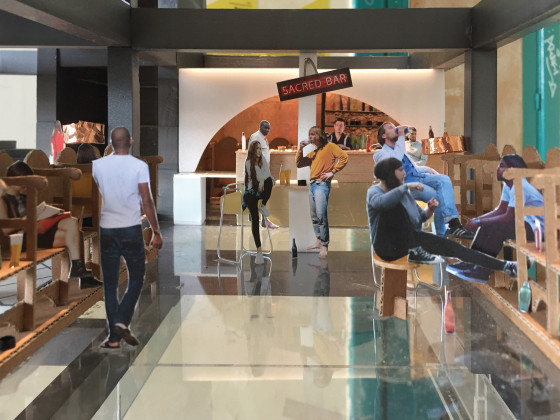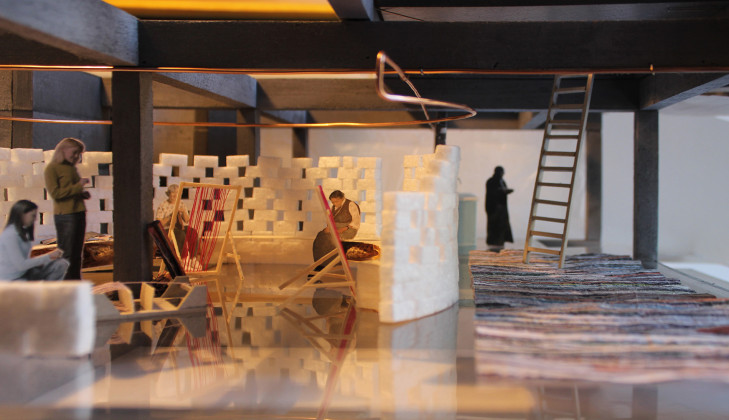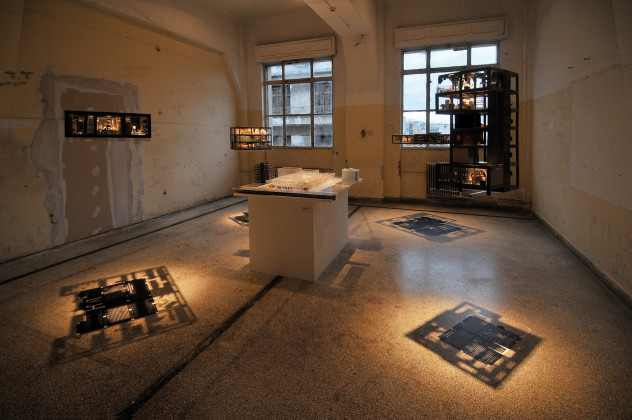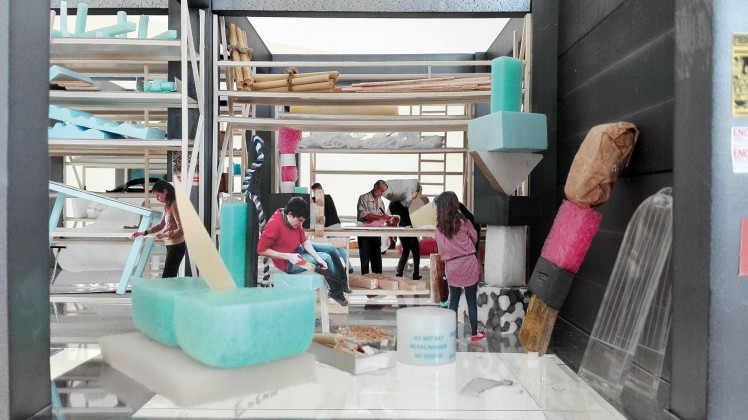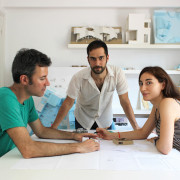The City Yet to Come
Displayed as a part of the ‘Tomorrows: Urban Fictions for Possible Futures’ exhibition at Onassis Cultural Center in Athens, ‘Victoria: Way In/Way Out’, a project by AREA, produces an urban scenario in the sense of state, citizenship and living together
In the summer of 2015, refugees from the Middle East took temporary shelter in Victoria Square, on their journey to Western Europe. Since then, Victoria, an urban space of bourgeois past and imperial name, has become a nexus of the refugee crisis, with an extended solidarity network providing shelter and guidance.
"Victoria: Way In/Way Out" imagines the space of Victoria Square as a paradigm for the future of the Mediterranean city. Two parallel urban entities coexist: the “Shelter” and the “Transparent State”. The first emerges within the concrete frames of former polykatoikies, or apartment blocks that now function as small, live-in "factories", where a diverse population of urban dwellers engages in the low-tech production and exchange of knowledge, products and services for a post-capitalist society. As an ever-changing, horizontal city perpetually linked to the present, the Shelter is intersected by the “Transparent State”: a formal and invariable network of radically privatized infrastructures and public spaces, with restricted access and limited rights, where constant surveillance guarantees safety and conformity to the past.
Victoria Square itself has been transformed into a new Crystal Palace, or “Embassy”, negotiating between the “Shelter” and the “Transparent State”. Mobility and the transitory nature of human occupation are everywhere on display, mediated by control points, waiting rooms and prepared experiences, whereby individuals may or may not be granted further access.
The Embassy
Constructed of bulletproof glass, the “Embassy” refers to Victoria Square’s aristocratic past by reconfiguring the facade of the Victorian era Crystal Palace, constructed during the reign of the English queen for whom the square is named. As a horizontal structure of outdoor rooms, with graduated levels of security, the Embassy represents both the monumentalization and fortification of public space within the “Transparent State” (T.S.). With its labyrinth-like qualities it “punctures” the space of the surrounding urban Shelter and is centered on the historic early 19th century bronze statue of Theseus.
As a result of the high security standards but also the automation of the labor force, the formal economy of the T.S. cannot include everyone. Only a limited population can have access at any given moment and for a limited time. In order to exit the space of the Shelter and enter into the T.S., interested parties must pass through the Embassy’s numerous evaluations, check points and control rooms before they are accepted, a process of undefined duration. A visit to the Embassy may thus become a time consuming process, but not without its pleasures. A series of imaginative experiences entertain the wait, transforming the square into an adult playground, where ever-human desires serve the interests of the T.S. through the production of docile bodies. In this way, the Embassy offers a singular opportunity for the enjoyment of once-popular “free time”, before entering into the “productive time” of the T.S. during the processing of entry applications. Aside from the waiting rooms, the Embassy incorporates a series of Fragments of the old square at the Embassy’s perimeter and which are preserved as museum examples of the past. Engaging in the practice of “Soft Power” through participatory diplomacy, these are the only spaces of free access, as they allow passersby to glimpse the internal operations of the Embassy, as a form of propaganda or an open invitation. Inasmuch as they are awarded access, residents of the Shelter can enter into the T. S., and its network of transportation and urban infrastructure, with temporary passports after giving up relevant rights (e.g. the right to privacy) and agreeing to the “Terms of Use”.
Electronic Messages / Embassy Rooms
- Welcome to the transparent state - Terms of use may change without prior notice
- Social contract - Terms of use - Social contract - Terms of use
- Join the transparent state today - 300 new openings - 3 months period - Apply now at the embassy @ Victoria Square - Previous admission required
- Bad behavior desk - Survive this bureaucratic mess and gain a two month extension on your stay
- Celebrate your individuality - Be the best you can be on the identity politics catwalk - complimentary drinks on us
- 3D body scan obligatory for first time applicants
- Learn how to navigate the labyrinth - Embassy orientation starts @ Theseus Statue @ Victoria Square - No minotaurs in the transparent state
- Soft power rooms - Learn more about the transparent state at the 20th century kiosk replica - Free access for all
- Soft power rooms - Fragments of 20th century Victoria Square - Free access for all
- Control room - Restricted access - Apply for admission here
- Sorry for the delay - Visit the adult playground now - Your experiences may be recorded for your safety
- During peek hours please limit your relaxation up to 20 minutes
- Build your own ruin at the subjective garden
- Personal items can be stored inside the transparent lockers - Don’t be shy, it’s for your safety
- Stress relief provided in the plastic flower garden - All scents are 100% natural extracts
- Transparent state news are performed daily at the media theater
- Take a pause to connect to the grid - Cable is always faster
- Get lost on the endless staircase
- Long queues ahead - Applicants are processed on a fifo protocol
- Work out and play but don’t feed the mechanic ducks
The Transparent State
In the future Victoria Square, the homonymous electric railway station is part of an extend-ed network of resources managed by the “Transparent State” (T.S.). Access to it is granted directly from the security apparatus known as the “Embassy” and extends to any point within the network. Very different from the current structure of the nation-state, the T.S. is a globalized, borderless network of urban and extra-urban infrastructures that extend across the European continent and exhibit all the characteristics of an expanded “smart city”. Rigid and unchanging, the T.S. functions more like a technologically advanced machine than a true political entity, while its zero-tolerance policy toward citizen participation is underlined by a mutually co-dependent relationship with residents of the urban “Shelter”. It is more about a technologically advanced machine than it is about a political entity, and citizens use it more than they participate in it. The greatest benefit offered to citizens by the T.S. is the temporary guarantee of security: whoever moves within its network is willing to give up his or her personal rights (e.g. the right to privacy) for the benefit of overall safety, asylum and freedom from violence, and is the privileged member of a formal labor economy, subject to taxation. The T.S. is premised upon digital technologies, procedural transparency, and continuous surveillance; but draconian and unyielding security protocols lead to its stagnation. It is thus supported by the parallel existence of the Shelter in order to replenish its human resources. Likewise, the Shelter is dependent on the T.S., since the latter manages basic resources like energy, fossil fuels and technological products.
Decorated Servers
Spread throughout the city, buildings that have been preserved as examples of cultural heritage become part of the T.S. network, like islands adrift in the urban Shelter. Their presence gives the illusion of temporal distance and progress, even though the T.S. has ceased to evolve. These are known as “Decorated Servers”, since they house the electronic systems (data processors and digital databases) necessary for the functioning of the T. S.
Τhe Shelter
Following years of decay, the apartment buildings that once surrounded Victoria Square have left only their skeletal remains as the basic material resource for future urban “Shel-ters”. The Shelter is defined as the contemporary condition of the “old” modernist city that continues to evolve through new forms of appropriation and habitation. It is tolerated by the Transparent State, since it cannot be controlled, and comes to characterize the Mediterranean city’s resistance to homogeneity and normalization. Its primary attribute is the ad-hoc habitation of those who cannot or choose not to access to the T.S. While passive individuality is a prerequisite to achieve entry into the T.S., the Shelter is characterized by the active collectivity of its members. Instead of the fixed formality of the former, the Shelter is continually transformed by its diverse community of users in response to the changing needs. Residents interact on the basis of an extensive and “smart” social network, by exchanging products, knowledge and services. Here, demographic diversity and personal connections are seen as a resource in an alternative, post-digital and post-capitalist barter economy. Within this everchanging network, one’s stay in the Shelter becomes both temporary and perpetual: some who live there wait enduringly for Embassy approval and entry into the T.S.; others who remain grapple with the freedoms of the “precariat” and its attendant life of impermanence.
Shelter 01: The School of Amateurs
The School of Amateurs is a horizontal structure of temporary co-habitation premised on the exchange of knowledge. A continuously renewed community of residents transmits idiosyncratic knowledge on a variety of productive skills with the goal that each participant will acquire multiple forms of competence. The exchange of knowledge becomes a form of capital. Amateur “polytechnics” differ in both approach and type of knowledge from certified professionals that are trained and occupied by the Transparent State. Like the rest of the "Shelter", the "School of Amateurs" is distinguished for its ephemeral character and changes in response to the moving carriers of knowledge. “Ateliers” tend to form as circular constructions, each one reproducing its own collectivity through different material means. As with all Shelters, the School of Amateurs is distinguished by its ephemeral nature. At this time, for example, one can learn knitting, creative writing, or learn about hydroponic cultivation of cannabis. Heraclitus might say that one never steps into the same school twice, as the population of resident-participants is in perpetual flux.
Shelter 02: The Factory of Useless Objects
The dominance of the virtue of efficiency in the Transparent State has made it impossible to evaluate qualities that are not relevant to the values of utilitarianism. The Factory of Useless Objects does exactly the opposite: indifferent to the use-value of objects, it is interested only in the ideas that objects provoke. In this sense, the Factory is akin to the place of “art” in the previous age. (In the Transparent State, museums and their contents have been mummified as fixed archives of the past, accessible only to private patrons and removed from public discourse.) The Factory is a hybrid entity that is simultaneously work space, storage facility, and guesthouse. Tenants spend their time both archiving and transforming the unused detritus of past objects. Archiving occurs according to qualitative and material characteristics, while transformations are aimed exclusively to surprise and disrupt expectations. New objects are presented in open discussions at the center of the space, especially at the landing of the old communal stairwell. The success and, therefore, theoretical value of all objects is determined solely by the richness of ideas that are provoked in discussion. All objects, however, are returned to the shelves, where they will undergo countless future transformations.
Shelter 03: Symposium
All that derives from the humanities, as well as religion, have been expelled from the Transparent State: art, philosophy and poetry, as opaque entities unable to be assessed in terms of efficiency and production, have been banished under the pretext of even greater efficiency. The failure of the T.S. to incorporate notions of creativity and critique attests to its inability to address change, despite a projected image of ongoing technological development. By contrast, members of the Symposium celebrate the ability of the good things in life (food, sex and proper company) to act as vehicles that unleash the full creative and intellectual potential of each individual.
- Clients of the Sacred Bar, including individuals of all backgrounds, congregate on a regular basis to determine the meaning of life.
- A kitchen that once belonged to an apartment becomes a one-room boarding house that doubles as a canteen. A few bartered goods and neighbourly relations are the price for home-cooked morsels and a little social-gossip-therapy.
- Visitors to the Loos Lounge share a nargile pipe and contemplate the claim that all that is needed for a space to become a dwelling is five rugs: one for the floor, and one for each wall (after all, who cares about the columns?).
- A nap parlour offers guests the forgotten pleasure of a Mediterranean siesta, and time to consider Plato’s assertion that Eros is good for the city.
- The Open Kitchen is a shared resource that fuels the entire symposium.
- Dionysos’ Terrace provides the opportunity to engage in the ever-present and rising temperatures of the Mediterranean sun while engaged in non-productive activity. Time to think.
Shelter 04: Heroic Medicine
Formal medical care is the exclusive privilege of those with access to the Transparent State and its private medical insurance. Within the Shelter, the gap in health care is met by Heroic Medicine clusters. Its roots are in the heroic medicine of the 18th and 19th century, whereby interventional medical practices conducted by non-professionals helped the first immigrants to North America to rebound from the difficulties and adverse conditions of their journeys at sea. Essentially a continuation of the School of Amateurs, therapies are based on the informal, shared knowledge of the community and not on specialized scientific expertise. The functioning of Heroic Medicine clusters is based on the Hypocratic theory of four bodily humors that must remain in balance: phlegm, yellow bile, black bile and blood, each with its attendant human character type:
Phlegmatic: relaxed and peaceful
Choleric : short-tempered, fast, or irritable
Melancholic : analytical, wise, and quiet
Sanguine: enthusiastic, active, and social
Each Heroic Medicine cluster attends to individuals from one of the four groups and applies “alternative” medical practices based on achieving a balance of mind, body and spirit. For example, the phlegmatic cluster provides yoga and energy therapies; the melancholic cluster includes acupuncture; the choleric cluster offers art and creativity workshops, and silence pods; and the sanguine cluster provides a vitamin and herb bar, aromatherapy and Chinese medicine.
 27.08.2018
27.08.2018



